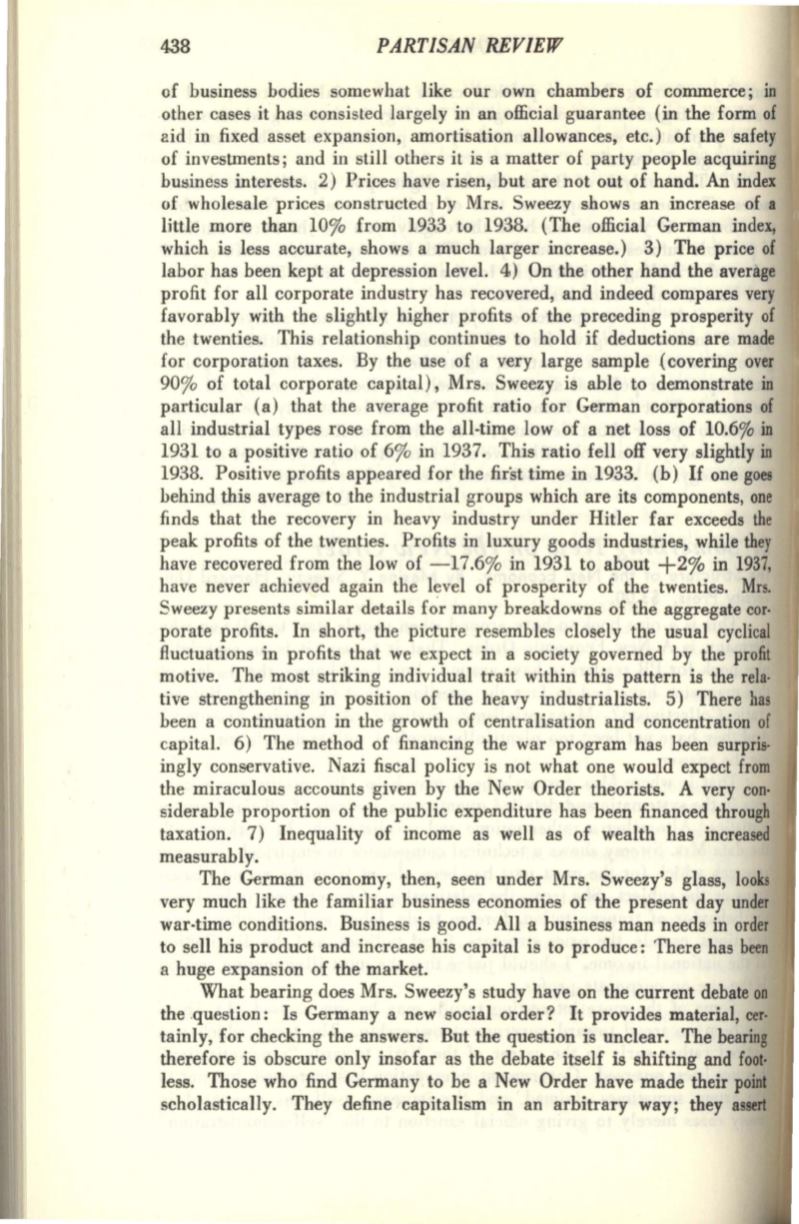
438
PARTISAN REVIEW
of business bodies somewhat like our own chambers of commerce; in
other cases it has consisted largely in an official guarantee (in the form of
aid in fixed asset expansion, amortisation allowances, etc.) of the safety
of investments; and in still others it is a matter of party people acquiring
business interests. 2) Prices have risen, but are not out of hand.
An
index
of wholesale prices constructed by Mrs. Sweezy shows an increase of a
little more than
10%
from
1933
to
1938.
(The official German index,
which is less accurate, shows a much larger increase.) 3) The price of
labor has been kept at depression level. 4) On the other hand the average
profit for all corporate industry has recovered, and indeed compares very
favorably with the slightly higher profits of the preceding prosperity of
the twenties. This relationship continues to hold
if
deductions are made
for corporation taxes. By the use of a very large sample .(covering over
90%
of total corporate capital), Mrs. Sweezy is able to demonstrate
in
particular (a) that the average profit ratio for German corporations of
all industrial types rose from the all-time low of a net loss of
10.6?'o
in
1931
to a positive ratio of
6%
in
1937.
This ratio fell off very slightly
in
1938.
Positive profits appeared for the first time in
1933.
(b)
If
one goes
behind this average to the industrial groups which are its components, one
finds that the recovery in heavy industry under Hitler far exceeds the
peak profits of the twenties. Profits in luxury goods industries, while they
have recovered from the low of
-17.6%
in
1931
to about
+2%
in
1937,
have never achieved again the level of prosperity of the twenties. Mrs.
Sweezy presents similar details for many breakdowns of the aggregate cor·
porate profits. In short, the picture resembles closely the usual cyclical
fluctuations in profits that we expect in a society governed by the profit
motive. The most striking individual ttait within this pattern is the rela·
tive strengthening in position of the heavy industrialists. 5) There has
been a continuation in the growth of centralisation and concentration of
capital. 6) The method of financing the war program has been surpris·
ingly conservative. Nazi fiscal policy is not what one would expect from
the miraculous accounts given by the New Order theorists. A very con·
siderable proportion of the public expenditure has been financed through
taxation. 7) Inequality of income as well as of wealth has increased
measurably.
The German economy, then, seen under Mrs. Sweezy's glass, looks
very much like the familiar business economies of the present day under
war-time conditions. Business is good. All a business man needs
in
order
to sell his product and increase his capital is to produce: There has been
a huge expansion of the market.
What bearing does Mrs. Sweezy's study have on the current debate on
the .question: Is Germany a new social order? It provides material, cer·
tainly, for checking the answers. But the question is unclear. The bearing
therefore is obscure only insofar as the debate itself is shifting and foot·
less. Those who find Germany to be a New Order have made their point
scholastically. They define capitalism in an arbitrary way; they assert


